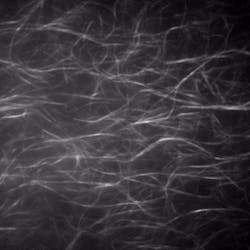Synthetic, self-made fibers have been found to guide molecular movement, which could be fueled by light over long distances, prompting the potential for light to be harnessed in new ways as a source for sustainable energy.
Researchers at the University of Nottingham (England) used a supramolecular system—an assembly of molecular sub-units organized through intermolecular interactions that can be ionic or covalent—in which a molecular “traveler” can be propelled by light along a path over several microns when irradiated with visible light (see figure).1
“In living organisms, molecular motors travel along specific molecular paths, [which] is an essential part of cell function,” says David Amabilino, a professor in Nottingham’s School of Chemistry and a lead researcher on this study. “We have shown that a synthetic, self-made molecular fiber in a liquid behaves like a path for the movement of a molecular traveler over a distance 10,000 times its length.”
Discovering interactions
In the study, interactions among oppositely charged chemical groups were used to create motion in what is typically a static system; the researchers introduced a switching molecule (“that flaps back and forth quite quickly”) into the fibers. Specifically, according to the team, the interaction of traveler molecules with the path as they move along is weakened when light is shone on it. This “can be at some distance,” the researchers found.
As the switching molecules are irradiated, heat is released; “that heat has a local effect that helps the traveler move, so the mechanical movement of the switch, and the heat that is released when it does, are important for making the system work.”
Reflection fluorescence microscopy allowed the researchers to simultaneously excite the traveling molecules and observe them as they emit light.
The Nottingham team’s system is “sensitive to the solvent in which the fibers are formed.” In a strong liquid, the traveling molecules move along the fibers to another location, according to study co-author Mario Samperi. He notes that when the liquid is weaker, “rings of rearranged fibers are formed where the travelers have moved along and incorporated into the newly formed circular track. We want to be able to transport other molecules from one place to another in a controlled way, so that the travelling molecules can carry a package from one place to another, emulating nature, but using light as energy.”
This is the first time such a system has been able to mimic such movement along fibers in cells.
“If we can find ways to make use of the light’s potential in this process,” Amabilino says, “then it could pave the way for use in light-activated medicines, new ways to harness light energy as a source of power, and to create new sustainable ways to carry out chemical tasks.”
REFERENCE
1. M. Samperi et al., Nat. Chem. (2021); doi:10.1038/s41557-021-00791-2.
About the Author
Justine Murphy
Multimedia Director, Digital Infrastructure
Justine Murphy is the multimedia director for Endeavor Business Media's Digital Infrastructure Group. She is a multiple award-winning writer and editor with more 20 years of experience in newspaper publishing as well as public relations, marketing, and communications. For nearly 10 years, she has covered all facets of the optics and photonics industry as an editor, writer, web news anchor, and podcast host for an internationally reaching magazine publishing company. Her work has earned accolades from the New England Press Association as well as the SIIA/Jesse H. Neal Awards. She received a B.A. from the Massachusetts College of Liberal Arts.

